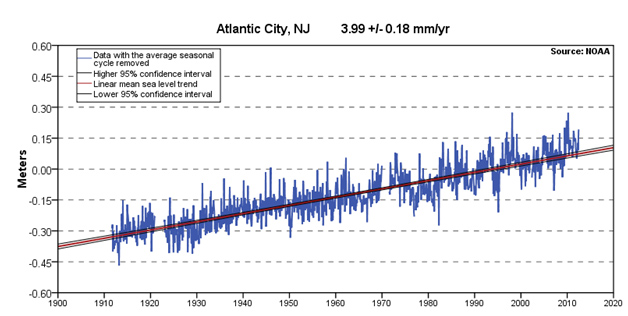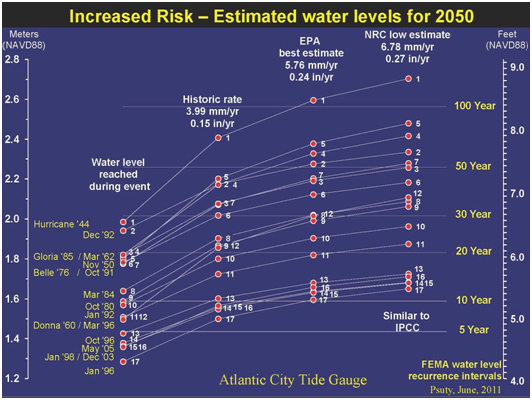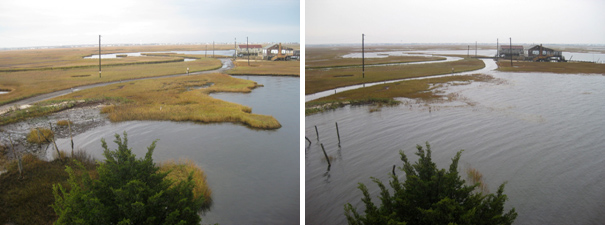Sea Level Rise and Flooding
Increased temperatures are predicted to lead to increasing rainfall intensity during severe storms. Additionally, warmer ocean temperatures could increase the intensity of tropical storms and hurricanes which, in turn, could increase flood and wind damages. Factors such as rising sea levels, disappearing wetlands, and increased coastal development threaten to intensify the damage caused by hurricanes and tropical storms.
Increasing rainfall intensity during severe storms is also predicted to lead to increased flooding of interior rivers and streams. What was once considered a 100 year flood (i.e. occurring once every 100 years or 1% chance of occurring in any given year) are now occurring with much higher frequency. Factors such as increased impervious surface and floodplain development lead to even more intense flooding and vulnerable human populations.
Is Sea Level Rising?
Yes, sea level rise is a physical reality that is impacting the New Jersey and the entire Mid-Atlantic coastline. The historical rate of sea level rise along the New Jersey coast over the past half century was 3-4 mm/yr (or 0.12 -0.16 in/yr), while predicted future rates are expected to increase to 12 mm/yr (or 0.5 in/yr). This means that by 2050 sea level rise is expected to rise by approximately 1 foot and by 2100 sea level rise is projected to rise about 3 feet along the Jersey shore.
 The mean sea level trend over the past century is 3.99 millimeters/year (0.15 in/yr) which is equivalent to a change of 1.31 feet in 100 years.
The mean sea level trend over the past century is 3.99 millimeters/year (0.15 in/yr) which is equivalent to a change of 1.31 feet in 100 years.
Graphic Credit: NOAA
Sea level rise increases the vulnerability of coastal areas to flooding during storms for several reasons. First, a given storm surge from a hurricane or northeaster builds on top of a higher base of water. Considering only this effect, it is estimated that development along the coast would experience a 36-58 percent increase in annual damages for a 1-foot rise in sea level, and a 102-200 percent increase for a 3-foot rise. Second, greater shoreline erosion also increases vulnerability to storms, by removing the beaches and dunes that would otherwise protect coastal property from storm waves.
 A graphic showing the what water levels could be when sea level rise is factored into known water levels from historical storms.
A graphic showing the what water levels could be when sea level rise is factored into known water levels from historical storms.
Why is Sea Level Rising?
Global sea level and the Earth's climate are closely linked. The Earth's climate has warmed about 1.8°F during the last 100 years. The two major causes of global sea level rise are thermal expansion of the oceans (water expands as it warms) and the loss of land-based ice due to increased melting. Along the Mid-Atlantic Coast, coastal lands are subsiding further exacerbating sea level rise. In addition, oceanographic effects due to shifting of the Gulf Stream will potentially affect sea level in this region.
Global sea level is projected to rise during the 21st century at a greater rate than during 1961 to 2003. Thermal expansion is currently contributing about half of the average rise, but land ice will lose mass increasingly rapidly as the century progresses. It is uncertain how much of the current land ice located in the Antarctic and Greenland ice sheets may melt.
How Do Tidal Cycles Affect Coastal Flooding?
Each month at the time of the new and full moon, especially strong tides (called spring tides) occur resulting in higher highs and lower low waters. A king tide is an especially high tide that occurs when the gravitational pull of the sun and moon reinforce one another. This extra-high tide happens twice a year at the times when the moon is closest to the earth. King tides can be 2-3 feet above normal MHHW and further exacerbate coastal flooding.
 Cedar Run Dock Road in Little Egg Harbor Bay flooding during the October 2011 king tide.
Cedar Run Dock Road in Little Egg Harbor Bay flooding during the October 2011 king tide.
Photo Credit: Leslee Ganss
Learn more about and see pictures of king tides.
For Additional Information
Federal Emergency Management Agency. 1991. Projected Impact of Relative Sea Level Rise on the National Flood Insurance Program. 70 pp. http://www.gpo.gov/fdsys/pkg/CZIC-hg9983-p76-1991/html/CZIC-hg9983-p76-1991.htm
IPCC, 2007: Climate Change 2007: The Physical Science Basis. Contribution of Working Group I to the Fourth Assessment Report of the Intergovernmental Panel on Climate Change [Solomon, S., D. Qin, M. Manning, Z. Chen, M. Marquis, K.B. Averyt, M.Tignor and H.L. Miller (eds.)]. Cambridge University Press, Cambridge, United Kingdom and New York, NY, USA. http://www.ipcc.ch/publications_and_data/publications_and_data_reports.shtml#1
National Oceanic & Atmospheric Administration. Ocean & Coastal Resource Management Coastal Issues: Climate Change, http://coastalmanagement.noaa.gov/climate.html
Psuty, N.P. and D.D. Ofiara. 2002. Coastal Hazard Management, Lessons and Future Direction from New Jersey. Rutgers University Press, New Brunswick, NJ
Rignot, E., I. Velicogna, M.R. van den Broeke, A. Monaghan and J. Lenaerts. 2011. Acceleration of the contribution of the Greenland and Antarctic ice sheets to sea level rise. Geophysical Research Letters 38: L05503
U.S. Environmental Protection Agency. Climate Change Impacts and Adapting to Change. http://www.epa.gov/climatechange/impacts-adaptation/